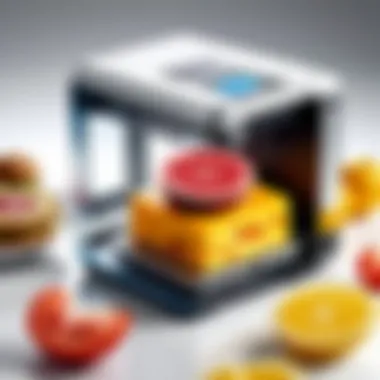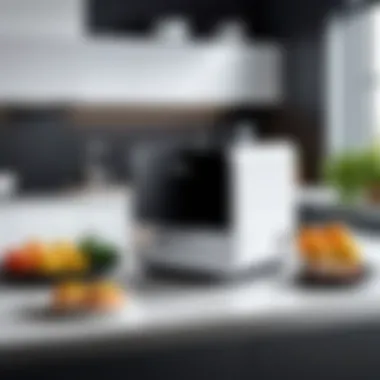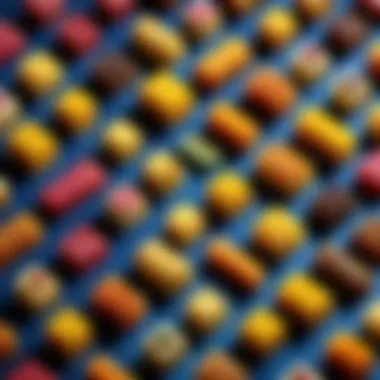Epson Food Printer: Merging Culinary Arts with Technology


Intro
In a world where technology continuously reshapes how we live, it has also found a whimsical home in kitchens, notably with the advent of food printers. Epson, a name synonymous with innovation, has ventured into this culinary realm, merging the arts of cooking and digital creation in remarkable ways. The complexities of human taste and the mechanics of food printing combine to offer chefs and home cooks an extraordinary canvas. Not merely for embellishment, these devices carry potential far beyond aesthetics. They challenge traditional culinary boundaries, presenting possibilities that were once the product of mere imagination.
The upcoming exploration navigates through the inner workings of Epson food printers, examining their unique capabilities and role in advancing food tech. We’ll break down the hardware and software involved, consider their practicality, and also analyze how they fared in real-life applications. It will include a discourse on trends shaping the food tech landscape and peek at the future potential, ensuring that this journey offers comprehensive insights for tech-savvy consumers and culinary artisans alike.
Intro to Epson Food Printers
Epson food printers represent a significant advancement in the culinary world, merging technology with artistry in ways that were once the stuff of dreams. Their introduction has elevated food presentation from merely plate arrangements to a canvas where chefs can showcase creativity in vibrant colors and intricate designs. The importance of understanding Epson food printers lies not only in knowing how they function but also in recognizing their transformative impact on culinary practices.
One of the most striking aspects of these printers is their ability to customize and personalize food. When preparing dishes for special events, the ability to print logos, messages, or intricate designs directly onto food can turn a simple meal into a remarkable experience. Guests at weddings, corporate events, or birthdays are often left in awe when served dishes that encapsulate personal touches, and Epson food printers make that possible.
Moreover, food printing aligns with current trends toward experiential dining. Diners, particularly younger ones, look for interactive experiences that engage multiple senses. The visual appeal created through the deployment of Epson food printers can enhance the overall dining experience, making it memorable and shareable on social media platforms.
From a business perspective, the versatility of these printers offers restaurateurs an opportunity to stand out in a competitive market. Incorporating food printing can help in branding and marketing, adding an innovative flair that might attract more customers, especially those with a taste for uniqueness.
However, as with any technology, there are considerations to take into account. Ensuring that food printers meet food safety standards and using high-quality inks suitable for consumption are paramount. As consumer awareness increases, the demand for transparency in food preparation practices will shape how food printing evolves.
In summary, integrating Epson food printers into culinary practices opens up a world rich in possibilities. The innovation they bring is not just about aesthetics; it's a multifaceted tool for enhancing flavor, personal expression, and business branding.
The Mechanics of Epson Food Printers
The mechanics of Epson food printers play a crucial role in understanding how this technology has blended seamlessly into culinary arts. These printers do more than just replicate images, they enable chefs to push the boundaries of creativity and presentation. With the ability to produce intricate designs directly onto food, they represent a significant leap not only in the aesthetics of dishes but also in the personalization of food for occasions and branding.
Printing Mechanisms and Techniques
Epson food printers utilize advanced printing mechanisms similar to traditional inkjet technology, but specially adapted for food applications. The way these printers function hinges on precision and the right technology. At the core, the printers use a process called thermal inkjet printing. This method takes advantage of heat to create tiny droplets of ink, which then land on the edible surface, allowing for a detailed transfer of designs.
The main advantage of this technology is its ability to produce high-resolution images. For instance, the Epson SureColor F-Series allows chefs to replicate a customer’s logo or a complex pattern with unparalleled clarity. This printing method is notable not just because of its precision, but also due to its speed. They can print multiple plates in a short span of time, which is a game-changer in busy restaurants or bakeries.
It's essential to consider the integrity of the food materials being printed on. Chefs can choose various substrates such as cookies, cakes, and even culinary cheeses, each requiring different techniques and ink viscosity. The adaptability of printing mechanisms makes the food printer highly versatile.
Types of Food Inks and Materials Used
Understanding the types of food inks and materials is equally vital when discussing Epson food printers. Food inks are specially formulated to be safe for consumption. Generally, they fall into two main categories: edible food colorants and plant-based inks.
- Edible food colorants: These are essential for vibrant colors. They can come from natural sources such as fruits and vegetables or can be synthetic. Chefs may choose to use organic colors derived from beet juice or spirulina to align with health trends in culinary arts.
- Plant-based inks: These inks have gained traction due to their reduced environmental impact. They utilize elements derived from plant sources, making them a preferred choice among eco-conscious chefs.
In terms of touch and feel, Epson food printers typically allow the use of various thicknesses of materials. For instance, delicate breads might require a lighter ink density compared to sturdier substrates like cakes. Moreover, chefs are given room for creativity, experimenting with textures and flavors, altering not only the visual appeal but also the dining experience itself.
"The intersection of creativity and technology in food printing allows not just for personalized meals but shapes the future presentation and customization in culinary arts."
By combining various inks and substrates, one can achieve truly stunning results. It's about allowing culinary artists to think outside the box and go beyond traditional plating.
Applications in the Food Industry
The application of Epson food printers extends far beyond mere novelty; they catalyze innovation across various segments of the food industry. From fine dining establishments to large-scale food manufacturing, these printers revolutionize traditional culinary practices, infusing creativity and personalization into food presentation. The significance of these applications lies not just in aesthetic appeal, but also in enhancing customer experience and operational efficiency.


Culinary Arts and Food Presentation
Food has always been more than sustenance. It serves as a canvas for chefs to express their creativity. With Epson food printers, professionals in the kitchen can print intricate designs and vivid colors directly onto edible surfaces. This technology allows chefs to replicate complex patterns, logos, or even artwork that was once thought to be unachievable in the culinary world.
Imagine walking into a restaurant and seeing a dessert that looks like a Van Gogh painting. Such visual presentation is not simply a trend; it is an integral part of a comprehensive dining experience that captivates guests and can elevate a dish’s perceived value.
"Incorporating food printers into culinary strategy can transform the mainstream ideas of presentation, prompting chefs to explore uncharted territory in artistic expression."
Utilizing food printers enables chefs to experiment with various edible inks, allowing for innovation in presentation. Products like red beet juice, spirulina, or saffron can create new color spectrums that enhance dishes. With consumers enjoying meals that are not only delicious but also visually stunning, the culinary arts continue to evolve, engaging diners in a more immersive experience.
Moreover, the precision of printing techniques ensures consistency across multiple dishes, an essential factor in high-volume kitchens. By standardizing the artwork on plates, chefs can maintain a brand's image, an important consideration in today’s competitive market.
Customizing Food for Events and Branding
Customization is king in the culinary world, particularly when it comes to events like weddings, corporate functions, or product launches. With Epson food printers, personalization of food items becomes straightforward. Event planners can work side by side with chefs to design menus that reflect the theme or branding of the occasion.
Picture a company celebrating its anniversary. With the help of a food printer, the logo can be printed on cakes or snacks, creating a memorable moment for guests and reinforcing brand identity. This technique not only enhances the atmosphere of an event but also promotes the business through visual engagement.
The ability to print specific messages or intricate designs on edible mediums opens doors in customer interaction, allowing a direct dialogue through very personal food experiences. The role of food in events transforms from simply being sustenance to becoming a part of the storytelling to an audience, thereby solidifying its cultural significance.
Innovations in Food Manufacturing
As food technology advances, the integration of printers into food manufacturing processes marks a pivotal shift. With customized food printing, manufacturers can maintain product consistency while catering to unique dietary requirements. For instance, utilizing Epson printers can facilitate the creation of gluten-free or allergen-free products by enabling precise ingredient control during the printing process.
Additionally, Epson printers can adapt to changing trends and consumer preferences swiftly by allowing manufacturers to experiment with flavors, colors, and nutritional value. The speed at which new products can be formatted and produced is substantially increased, thereby shortening the time from concept to market.
Furthermore, this technology can also help in reducing food waste. By accurately printing the exact portion size intended for consumption, companies can minimize excess production, thus aligning with sustainable practices becoming more prevalent in the industry.
Notable Models of Epson Food Printers
In the realm of food printing, Epson stands out with its specialized models that have made a significant impact on both culinary creativity and commercial viability. Understanding these models is crucial for anyone interested in leveraging cutting-edge technology in food production. The Epson food printer range brings forth unique features that cater to different needs and uses, from professional kitchens to home setups. Here, we’ll explore two notable series: the Epson SureColor F-Series and the Epson EcoTank Series, and examine their importance in revolutionizing food art and design.
Epson SureColor F-Series
The Epson SureColor F-Series is a powerhouse in the food printing landscape, often embraced by professional chefs and culinary artists. This line employs dye-sublimation printing, allowing vibrant colors and intricate designs to grace a variety of edible surfaces. The technological finesse of the F-Series means it can replicate even the most delicate details, making it a favorite for businesses that prioritize presentation.
One key advantage of the SureColor F-Series is its versatility. It can print on an array of substrates including sugar sheets, chocolate, and other food-safe materials. In practical terms, this means that a bakery could use it to create personalized cakes adorned with detailed images, or a catering service might wish to craft signature dishes that showcase their brand’s aesthetic.
Moreover, the caliber of ink used in the F-Series is a noteworthy consideration. Epson prides itself on using high-quality, food-grade inks that are not only vibrant but also safe for consumption. Following food safety protocols while maximizing design capabilities isn’t just a luxury; it’s a necessity in the food industry.
Epson EcoTank Series
On the other end of the spectrum, the Epson EcoTank Series offers an innovative approach to food printing suitable for smaller establishments or even home kitchens. This line is designed for efficiency, featuring an integrated tank system that reduces the frequency of ink replacements. For many, maintaining ongoing costs while producing creative edible art is a central concern. The EcoTank helps alleviate this anxiety by providing a sustainable option.
The EcoTank also excels in ease of use. Its straightforward setup and user-friendly interface allow those less familiar with food printers to engage in intricate designs without a steep learning curve. Many find that the EcoTank supports their culinary aspirations without introducing complexity, striking a pleasing balance between technology and ease of access.
Comparison of Features and Pricing


When weighing the practicalities of these two series, various factors come into play. Both the Epson SureColor F-Series and the EcoTank offer unique strengths, but they cater to different segments of the market.
- SureColor F-Series:
- EcoTank Series:
- Ideal for commercial kitchens and professional chefs
- Higher initial investment, reflective of its advanced technology
- Superior resolution and color accuracy
- Versatile substrates for a variety of creative applications
- More accessible price point, suitable for smaller operations or individual use
- Cost-effective with refillable ink tanks
- User-friendly design makes it accessible for beginners
- Focused on small-scale projects and home culinary applications
In summary, whether you're a professional chef looking to elevate your presentation or a home cook wanting to personalize your meals, both models offer valuable attributes to consider. The choice ultimately hinges on your specific requirements and aspirations in the culinary arts.
Quality and Safety Considerations
In discussing food printing technology, particularly as it pertains to Epson models, an important area of focus is the balance between innovation and safety. Understanding the quality and safety considerations in using food printers is essential not just for culinary professionals but also for home cooks aspiring to elevate their dishes. These factors ensure that creativity doesn't compromise health.
Ensuring Food Safety Standards
Food safety is paramount in any culinary endeavor, and it takes on a new dimension when we introduce technology like food printers. These devices bring forth exciting possibilities, but they also require strict adherence to food safety standards to mitigate risks. The food inks used in Epson printers are formulated for specific regulations set forth by food safety authorities, which means they must be non-toxic and free of harmful additives.
Here are some key elements to consider for ensuring food safety:
- Certification: Always check if the food inks are certified for direct contact with food. Safe inks should comply with regulations such as the FDA or EU food safety standards.
- Hygiene Practices: Ensuring that the printer itself is clean is crucial. Regular cleaning of the nozzle and printing surfaces prevents cross-contamination from leftover materials.
- Storage Conditions: The environment where food materials are stored matters. Proper refrigerating and protecting inks from contamination must be practiced, just like with any food item.
Ultimately, the aim is to harmonize creativity with safe practices, ensuring that food produced with Epson’s technology is both delightful to the palate and safe for consumption.
Quality of Food Inks: What to Know
When it comes to food printing, the quality of the inks is as significant as the printer itself. Around the world, consumers are becoming savvy about what goes into their food, and rightly so. Using high-quality food inks not only determines the overall look of printed products but also influences flavor and safety.
Here are some insights regarding food inks:
- Composition: Food inks typically contain edible colorings derived from natural sources, though synthetic alternatives exist. Knowing what’s in your ink can help in making informed choices that align with dietary restrictions or preferences.
- Stability and Shelf Life: Quality inks maintain their color and consistency over time. Look for inks that offer longevity, since faded or dried-out inks can spoil the visual appeal of printed designs.
- Taste Impact: While many food inks are designed to be tasteless, others might impart a flavor that interferes with the dish. Sample various inks to discover which ones complement the foods you are experimenting with.
User Guidelines for Epson Food Printers
In a world where culinary creativity meets groundbreaking technology, understanding how to operate and maintain an Epson food printer is paramount. The user guidelines serve as a roadmap, guiding both novices and seasoned chefs to fully harness the power of these machines. The benefits of carefully following these guidelines extend beyond mere operation; they encompass quality control, safety, and longevity of the printer. Improper use can not only lead to unsatisfactory results but may also compromise food safety—a critical consideration in any culinary endeavor.
Setting Up Your Epson Food Printer
Setting up an Epson food printer might seem like a straightforward process at first glance, but there are nuances that can significantly influence your printing experience. Begin by finding a location that’s away from direct sunlight and dust, as these factors may interfere with the printer's performance.
- Power Source: Make sure your printer is plugged into a stable electric outlet. Sudden power cuts can disrupt printing and possibly damage the internal components.
- Connectivity: Depending on the model, you may need to connect the printer via USB or Wi-Fi. Read the manual for step-by-step connection instructions, as they can vary. Good connectivity ensures smooth data transfer, which is essential for achieving high-quality prints.
- Software Installation: Download the appropriate driver and software from the Epson website. This step is crucial as it ensures the printer works seamlessly with your computer or design software.
After that, take a moment to calibrate the printer according to the manufacturer's recommendations. Calibration ensures the printer operates at its best, enabling it to lay down precise layers of food inks that create stunning and edible art. Don't forget to test the printer with a practice run using edible paper or frosting sheets before moving on to your masterpiece.
Maintenance and Troubleshooting Tips
Regular maintenance is like oiling the gears in a well-tuned machine; it keeps everything running smooth as silk. An Epson food printer, while robust, requires some care to function optimally.


- Cleaning the Printer Heads: Clogged printer heads are among the most common issues faced. Epson provides an automatic cleaning option within the printer’s software. However, if you notice streaks or uneven coloring in prints, it may be time to run a manual cleaning cycle. It usually involves a few clicks on your computer, and most models walk you through the process easily.
- Storing Food Inks: Environmental factors play a significant role in the longevity of food inks. Store inks in a cool, dark place, away from heat sources. Any exposure to extreme temperatures can change their composition, resulting in muted colors when printed.
- Troubleshooting Common Issues: If you encounter problems, consult the printer’s manual. Most models have a troubleshooting section that can provide quick fixes to common dilemmas like paper jams or connectivity issues. Make sure to document any error messages, as these can be useful should you need to contact Epson customer service for assistance.
"An ounce of prevention is worth a pound of cure." Keeping ahead of maintenance ensures your Epson food printer performs at peak efficiency, minimizing the risk of getting caught in a jam, quite literally.
In summary, by understanding the setup process and maintaining your Epson food printer properly, you can optimize its performance and unleash its full potential in your culinary undertakings. From delicious custom cakes to festively adorned treats, being equipped with the right knowledge turns any kitchen into a canvas.
Future Trends and Innovations in Food Printing
When we consider the vast implications of food printing, especially with the advances made by Epson, it quickly becomes clear that this technology is more than just a passing trend. It’s reshaping culinary creativity and operational efficiency across the food industry. This section looks at how research and development are pushing boundaries, and how Epson is very much at the forefront of these innovations.
Research and Development in Food Technology
For tech enthusiasts and culinary experts alike, the excitement surrounding food technology stems from more than just novelty; it points to groundbreaking research that continuously opens new doors.
Research is currently underway to harness a variety of ingredients, from natural colorants to functional food compounds, into printable formats. This development means not only aesthetically pleasing dishes but also fortified foods that cater to specific dietary needs.
The potential within this research realm is vast:
- Nutritional Enhancement: Food printers could be used to add extra vitamins and minerals right into your meal, appealing to health-conscious consumers.
- Sustainability: Using local or underutilized crops can reduce food waste and enhance food security.
- Personalization: Future printers might allow users to customize their meals digitally, accommodating diverse preferences or dietary restrictions.
As these innovations keep evolving, they hinge on rigorous testing and regulatory compliance, ensuring that food safety remains paramount while enabling chefs to push the envelope.
The Role of Epson in Envisioning Future Directions
Epson’s contributions to food printing cannot be understated. The brand not only leads with its technology but manifests a vision for the culinary landscape that integrates tech and traditional cooking.
Epson continuously invests in research and development to not only improve the mechanics of their printers but also enrich the user experience. This includes designing interfaces that simplify the process of food printing, enabling even amateurs to produce beautiful and intricate designs.
Innovative Features to Highlight:
- Ink Technology: Epson’s proprietary food inks are crafted to meet safety standards, ensuring they’re as palatable as they are striking.
- Versatile Applications: Beyond bakeries and restaurants, Epson’s food printers are envisioned to revolutionize personal kitchens, making gourmet culinary arts accessible to everyone.
The overarching goal remains clear: to empower chefs—both professional and amateur—by blending technology with creativity, thus offering a platform where anyone can explore their culinary ambitions.
"The integration of technology and cuisine signifies a new culinary renaissance — one where Epson leads the charge toward infinite creativity."
Looking ahead, food printing not only represents enhanced creative freedom for chefs but also reflects increasingly personalized food experiences. Epson is not just keeping pace with trends; it's steering the direction of food printing into a future filled with flavor and innovation.
The End
As we wrap up our exploration into the realm of Epson food printers, it becomes clear that this technology is not merely a fleeting trend but rather a significant evolution in the culinary industry. The impact of these printers is multifaceted, touching on aspects ranging from enhanced creativity in food design to practical applications in commercial kitchens.
The Impact of Epson Food Printers on Culinary Practices
The introduction of Epson food printers has fundamentally shifted how chefs and food artists approach their craft. These machines enable the realistic printing of intricate designs, allowing for visually stunning presentations that catch the eye. Imagine a gourmet dessert plated with an exquisite floral pattern, all rendered with precision right before serving. Chefs can now push the envelope of traditional culinary presentation, transforming a simple dish into a captivating artwork that invites admiration before it is even tasted.
Moreover, these printers play a crucial role in personalization. In events like weddings or corporate gatherings, food can be customized to reflect the guests’ preferences or themes. Such flexibility enables culinary professionals to offer a unique experience that is increasingly important in a market where customers seek distinctiveness. The democratization of food art means that even home cooks can indulge in elevated creativity, enhancing family gatherings with personalized plates or special occasions.
Final Thoughts on Integrating Technology in Food Production
In considering the integration of technology in food production, it is essential to recognize the implications for both quality and efficiency. Epson food printers not only streamline the artistic process but also ensure consistency across multiple servings. This feature is particularly important in commercial environments where standards must be upheld to maintain brand integrity. The technological backbone provided by these devices allows chefs to focus their energies on innovation instead of repetitive, manual labor.
On a broader scale, the synergy between technology and culinary arts suggests a future where food production is more sustainable and accessible. As these printers utilize food-safe inks and are designed with sustainability in mind, they pave the way for eco-friendlier practices in kitchens worldwide.
"Technology has the potential to redefine our culinary experiences, making them more engaging, personalized, and sustainable."



